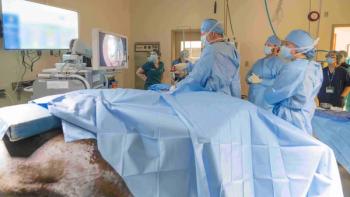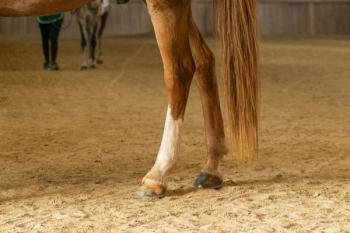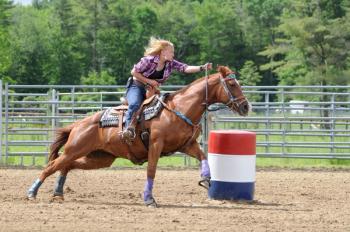
Corneal disease of horses (Proceedings)
Scraping for cytology and cultures: The cultures should be done before any drops, (drugs contain bacteriostatic agents), topical anesthetics and the handle end of a scalpel blade to scrape, sterile dacron swabs for culture.
Diagnostics
• Scraping for Cytology and Cultures
o The cultures should be done before any drops, (drugs contain bacteriostatic agents)
o Topical anesthetics and the handle end of a scalpel blade to scrape.
o Sterile dacron swabs for culture.
• Culture cornea BEFORE applying anything to the eye if overt infection is suspected
o Aerobic
o Fungal
• Fluorescein stain every eye that is PAINFUL!
o Blepharospasm
o Epiphora
o Redness
o Corneal opacities
• Rose Bengal Stain
o Viral Keratitis
o Early Fungal Keratitis
o Assess tear film
• Deep corneal scrapings, at the edge and base of the ulcer to detect bacteria and fungal hyphae
• Obtained with topical anesthesia and the blunt, handle end of a sterile scalpel blade.
• Superficial swabbing cannot be expected to yield fungi in a high percentage of cases.
Corneal ulceration
• Characterize
o Depth
• Superficial
• Deep (Stromal)
• Descemetocele
• Perforating
o Cause
• Infectious (fungal, bacterial, viral)
• Traumatic
• Immune-mediated
o Duration
• Response to previous treatments
Superficial ulceration
• Epithelium only
• Foals (Increased incidence compared to adults)
o Corneal sensitivity in foals is very poor.
o Lower tear production in foals compared to adult's
• Painful
Stromal ulceration
• Epithelium and collagen is lost
• Variation of the clinical picture
• Descemetoceles
o Epithelium and stroma are not present
o Buldge of DM into the defect
o EMERGENCY!
Corneal rupture
• Iris Prolapse
o Is this an EMERGENCY?
• Owner's Expectations?
o Cosmetic = Time and $$
o Enucleation?
• Treat as if globe is infected
o Systemic Antibiotics
o Cannot chance bacterial encephalitis
Bacterial ulcerations
• Gram Positive
o Streptococcus -hemolyticus
o Staphylococcus spp.
o Corynebacterium spp.
• Gram Negative
o Pseudomonas aeruginosa
o Aspergillus
o E. coli
• Treatment Options
o Gram Positive
• Triple Antibiotic
• Solution or Ointment
• Chloramphenicol
• Ointment
• Solution (1 gram vial with 10-15cc of sterile water)
• Cefazolin
• Solution (1 gram vial diluted with 5ml sterile water)
• Ciprofloxacin
• For Staph.
• Treatment Options
o Gram Negative
• Gentocin
• Solution or Ointment
• Tobramycin
• Ciprofloxacin
• Chloramphenicol
• UVEITIS
o Noted with all bacterial ulcerations!
Anti-proteolytic medications
• N-Acetyl Cysteine 5-10%
o MOA: MMP Inhibitor : Chelating Ca
o 5 mL 20% Mucomyst in 15 mL artificial tears
• EDTA 0.2%
o MOA: MMP Inhibitor : Chelating Ca
o 5ml of sterile water to lavender tube (EDTA)
• If larger tube fill with sterile water until vacuum is gone
• Galardin (Ilomostat®)
o Commercially available
o Antproteinase solution
• Inhibits MMP1, MMP3 and MMP9
o Demonstrated in rabbit model to work very well
• Serum
o MOA: MMP and serine protease inhibitors
o Good for 7-8 days refrigerated
o Cheap!!
• Tetanus Anti-toxin
o MOA: MMP and serine protease inhibitors
• I tend to use 2 anti-proteolytic medications
Fungal infections
• Aspergillosis and Fusarium
o Common Fungal isolated in horses
• Think Fungal Keratitis if:
o Ulcer is refractory to treatment with topical antibiotics
o Stromal Melting
o Lives or has traveled in warm/humid environment
o Lack of vascularization despite chronicity of ulcer
o Severe blepharospasm despite small size of ulcer
o Eye has been treated with steroids
o Uveitis increases after treatment with antifungals
• Can be VERY frustrating
• Can present with a wide variety of appearances
• Can do whatever they want to – despite appropriate therapy
o Most likely will need surgical intervention
• Lots of PMN
o To small to ingest the hyphae
o Release LOTS OF PROTEASES
• Antiangiogentic factors
• Slow healing
o 4-6 weeks minimum
• Topical Treatment
o Natamycin 3.3 % Solution
• Take new bottle (5%) and add 7.5cc Sterile water to make a 3.3% solution
• Produced by Streptomyces spp.
• Normally found in equine conjunctiva/cornea
• Most Physiologically appropriate? (per Dr. Brooks)
o Fluconazole 1%
o Itraconazole 1% with 30% DMSO Ointment
• Nice levels in the cornea
o Miconazole Vaginal Cream
o SSD
o Betadine Solution
o Vericonazole
• Be aggressive Q1-2 hrs if needed
• Treat Uveitis
o Can be severe
o Flunixin meglumine
o mg/kg PO or IV BID
o Atropine Q 4-6 hrs
• Treat with Antiprotease
• Treat with broad spectrum antibiotic
o Neopolybac
• Repeat Cytology and C/S
o If the eye first responds to treatment then deteriorates.
• May have secondary invasion of bacteria
• GOALS OF THERAPY Resolve Infection
• HALT Keratomalacia
• Control Uveitis
o Dilate Pupil
o NSAIDS
• Provide Structural Support
• Simple Ulcer
• Neopolybac Ointment
• Uveitis
o Banamine
o Atropine Q8hrs to affect
Newsletter
From exam room tips to practice management insights, get trusted veterinary news delivered straight to your inbox—subscribe to dvm360.




